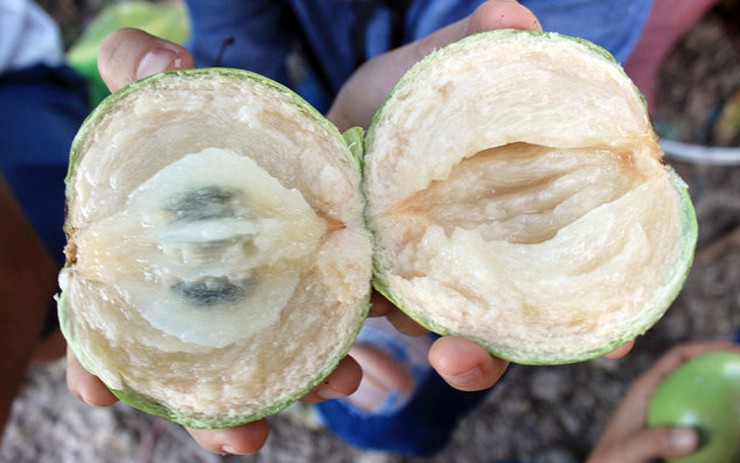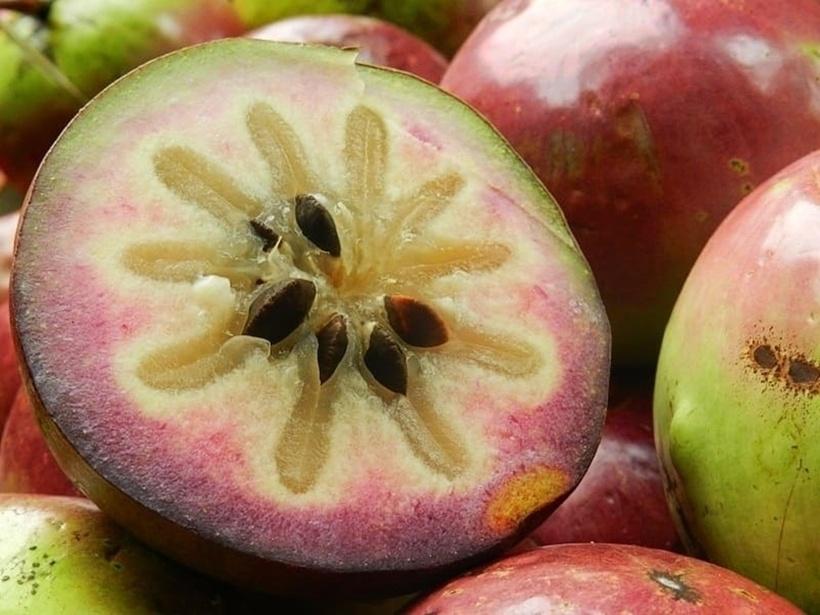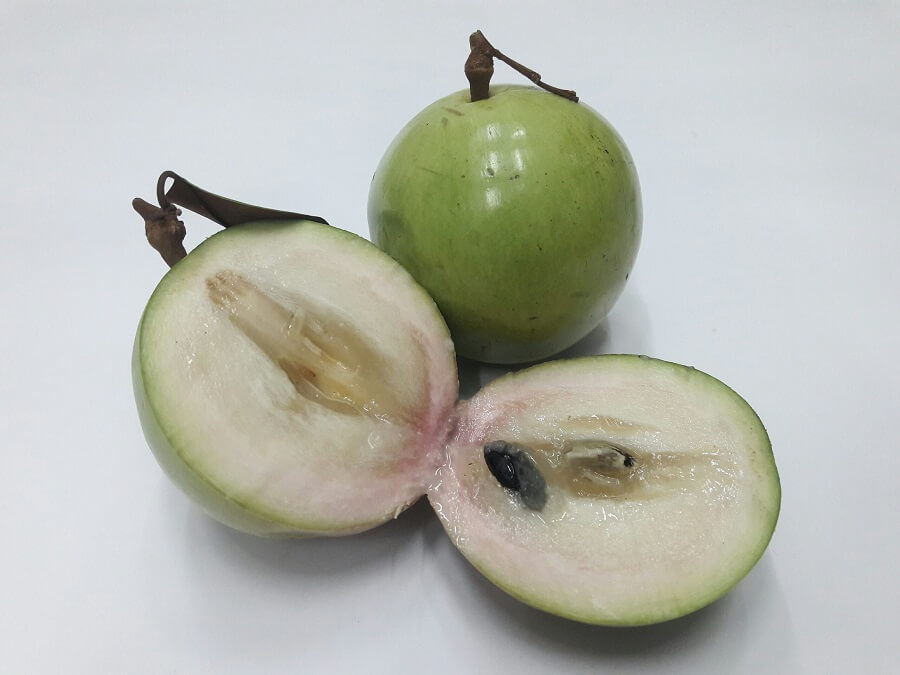Introduction
The Star Apple, known scientifically as Chrysophyllum cainito, is a tropical fruit that captivates with its unique flavor, rich nutritional profile, and numerous health benefits. Known as “quả vú sữa” in Vietnam, this fruit is celebrated not only for its delightful taste but also for its cultural significance and diverse uses in traditional medicine. In this comprehensive guide, we will explore the origins, characteristics, cultivation, nutritional benefits, culinary uses, and cultural significance of the Star Apple.
Origins and History
Botanical Background
The Star Apple is native to the Caribbean and Central America but has spread widely to tropical regions across the globe. Belonging to the Sapotaceae family, it shares a lineage with other tropical fruits such as sapodilla and mamey sapote.
Spread and Cultivation
Introduced to Southeast Asia, particularly Vietnam, the Star Apple thrives in the warm, humid climates typical of tropical regions. Vietnam, along with the Philippines and Thailand, has become a major producer of this exotic fruit.

Characteristics of the Star Apple
Appearance
The Star Apple is a round, slightly flattened fruit with a smooth, shiny skin. Depending on the variety, the skin color can range from green to purple, with some varieties exhibiting a gradient of both colors. The name “Star Apple” comes from the star-like pattern seen when the fruit is cut transversely.
Texture and Flavor
Inside, the flesh is juicy and custard-like, with a sweet, milky flavor that gives it the Vietnamese name “vú sữa,” meaning “milk breast.” The flesh is typically white, with a jelly-like texture near the core and a sweet, creamy consistency throughout.

Seeds
The fruit contains several dark brown seeds that are glossy and smooth. These seeds are not edible but can be used for propagation.
Nutritional Benefits
Vitamins and Minerals
The Star Apple is a powerhouse of essential nutrients. It is rich in vitamins A and C, both of which are crucial for maintaining healthy skin, vision, and immune function. It also contains significant amounts of potassium, calcium, and phosphorus, which are vital for bone health and cardiovascular function.

Antioxidants
The fruit is high in antioxidants, including polyphenols and flavonoids, which help combat oxidative stress and reduce the risk of chronic diseases such as heart disease and cancer.
Dietary Fiber
The Star Apple is an excellent source of dietary fiber, aiding in digestion and promoting a healthy gut. Regular consumption can help prevent constipation and other digestive issues.
Health Benefits
Immune Support
Thanks to its high vitamin C content, the Star Apple can boost the immune system, helping the body fight off infections and diseases more effectively.
Heart Health
Potassium, an abundant mineral in the Star Apple, helps regulate blood pressure and maintain heart health. The fruit’s fiber content also aids in lowering cholesterol levels.
Bone Strength
Calcium and phosphorus in the Star Apple are essential for maintaining strong bones and teeth. Regular consumption can help prevent osteoporosis and other bone-related issues.
Weight Management
With its low-calorie content and high fiber, the Star Apple is an ideal snack for those looking to manage their weight. It provides a feeling of fullness, reducing the likelihood of overeating.

Culinary Uses
Fresh Consumption
The Star Apple is best enjoyed fresh. To eat it, simply cut the fruit in half and scoop out the flesh with a spoon. It can be chilled beforehand for an even more refreshing treat.
Desserts and Beverages
The fruit’s sweet, creamy texture makes it a perfect ingredient for desserts and beverages. It can be added to fruit salads, smoothies, and ice creams, enhancing their flavor and nutritional value.
Traditional Dishes
In Vietnamese cuisine, the Star Apple is often used in traditional desserts such as chè, a sweet soup made with coconut milk, or as a topping for sticky rice.
Preserves and Jams
The Star Apple can also be used to make preserves and jams, allowing you to enjoy its unique flavor year-round.
Cultural Significance
Symbolism
In Vietnamese culture, the Star Apple is not just a fruit but a symbol of maternal love and nourishment, reflected in its name “vú sữa.”
Festivals and Traditions
The fruit is often featured in traditional festivals and rituals, symbolizing abundance and prosperity. During the Tet festival (Vietnamese Lunar New Year), it is common to see Star Apples included in fruit offerings.
Folklore and Legends
There are various folklore stories and legends surrounding the Star Apple in Vietnam. One popular tale speaks of a mother’s love and sacrifice, which is why the fruit is deeply respected and cherished.
Cultivation and Harvesting
Growing Conditions
The Star Apple tree thrives in warm, tropical climates with plenty of sunlight and well-drained soil. It requires regular watering, especially during the dry season.

Planting and Care
Propagation is typically done through seeds or grafting. The trees need to be spaced adequately to allow for growth and air circulation. Regular pruning helps maintain tree health and promotes better fruit production.
Harvesting
The fruit is usually harvested by hand when it reaches full maturity. Depending on the variety, this can be between four to six months after flowering. A gentle twist and pull are sufficient to pick the fruit without damaging the tree.
Environmental Impact and Sustainability
Biodiversity
The cultivation of Star Apple trees supports biodiversity by providing habitats for various species of birds, insects, and other wildlife.
Soil Health
These trees also contribute to soil health by preventing erosion and enriching the soil with organic matter from fallen leaves and fruits.
Sustainable Practices
Implementing sustainable farming practices, such as organic farming and integrated pest management, can further enhance the environmental benefits of Star Apple cultivation.
Challenges and Opportunities
Pests and Diseases
Like many fruit trees, the Star Apple is susceptible to pests and diseases, including fruit flies and fungal infections. Effective management practices are crucial to ensure healthy crops.

Market Potential
With growing awareness of its health benefits and unique flavor, the market potential for Star Apple is significant. There is an opportunity to expand its cultivation and reach new markets globally.
Research and Development
Ongoing research into improving cultivation techniques, pest management, and post-harvest handling can help increase the yield and quality of Star Apple, benefiting both farmers and consumers.
Conclusion
The Star Apple is more than just a delicious fruit; it is a symbol of cultural heritage, a source of numerous health benefits, and a contributor to environmental sustainability. By incorporating this unique fruit into your diet and supporting sustainable farming practices, you can enjoy its many advantages while contributing to a healthier planet.
Explore the world of Star Apple and discover how this remarkable fruit can enrich your life and the environment. Whether enjoyed fresh, in desserts, or as part of traditional dishes, the Star Apple offers a taste of nature’s delight that is both nourishing and satisfying.









